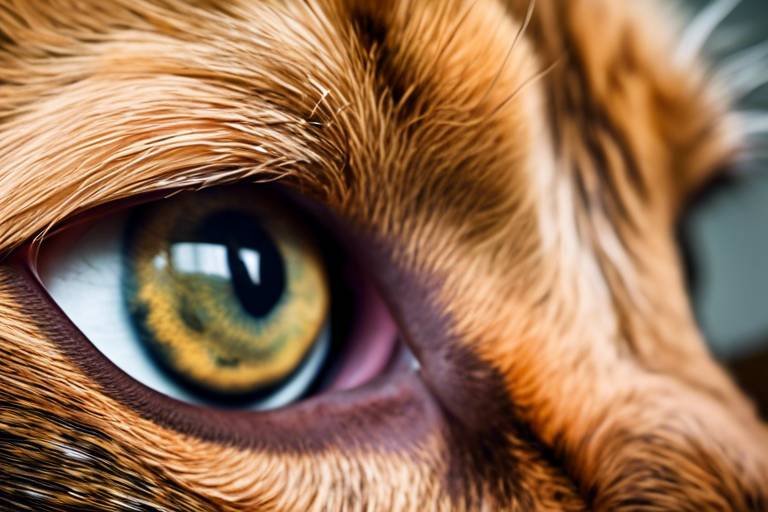What to Do If Your Pet Has a Seizure
When our furry friends experience a seizure, it can be one of the most distressing moments for any pet owner. The sight of your beloved pet convulsing can send your heart racing and leave you feeling helpless. But fear not! Understanding how to respond effectively can make a world of difference. This article aims to provide you with essential guidance on what to do when your pet has a seizure, ensuring both immediate safety and long-term health considerations.
Seizures in pets are not just scary; they are complex neurological events that can stem from various causes. Just like humans, pets can experience different types of seizures, ranging from mild twitching to full-body convulsions. These episodes can occur due to factors such as epilepsy, toxins, metabolic issues, or even brain tumors. Recognizing the signs of a seizure is crucial. Common symptoms include:
- Uncontrollable shaking or twitching
- Loss of consciousness
- Stiffening of the body
- Paddling of the legs
- Excessive drooling
Understanding what might trigger these seizures can also help you manage your pet's health better. Stress, certain foods, and environmental changes can all play a role. By being aware of these triggers, you can take proactive steps to minimize their occurrence.
When your pet is having a seizure, your immediate response is crucial for their safety. First and foremost, stay calm. Your pet can sense your anxiety, which may only increase their stress. Here are some key actions to take:
During a seizure, your primary goal is to create a safe space for your pet. This means removing any potential hazards from the area. Think of it like a protective bubble; you want to ensure that your pet doesn't hurt themselves on furniture, stairs, or any sharp objects. If possible, gently guide them away from these dangers without causing panic.
Proper positioning can make a significant difference during a seizure. If your pet is on their side, that’s ideal. It helps keep their airways clear. Avoid putting your hands near their mouth, as they may inadvertently bite you. Instead, use a soft blanket or cushion to support their body and keep them comfortable.
Timing is essential during a seizure. Use your phone or a stopwatch to note how long the seizure lasts. If it exceeds five minutes, or if your pet has multiple seizures in a row, it’s time to seek veterinary assistance. This information will be invaluable to your veterinarian in diagnosing the issue.
Once the seizure has ended, your pet may be disoriented or confused. This postictal state is normal, but it’s important to monitor their behavior closely. Offer gentle reassurance and a quiet space for them to recover. Keep an eye on them for any unusual behaviors, such as excessive pacing or whining, and be prepared to contact your vet if needed.
Knowing when to consult a veterinarian can be lifesaving. If your pet experiences their first seizure, if the seizure lasts longer than five minutes, or if they have multiple seizures in a short period, you should seek immediate veterinary care. Other concerning signs include:
- Seizures occurring in clusters
- Unresponsiveness after the seizure
- Difficulty breathing
Your veterinarian may recommend various diagnostic tests to determine the underlying cause of the seizures. These can include blood tests, urine tests, and imaging studies like X-rays or MRIs. Understanding these procedures can help alleviate your concerns and prepare you for what to expect.
Managing seizures often requires a multifaceted approach. Treatment options may include medications to control seizures, dietary changes, and lifestyle adjustments. Your vet will work with you to create a personalized plan that aims to improve your pet's quality of life.
Taking proactive steps can significantly reduce the likelihood of your pet experiencing seizures. Consider implementing the following preventive measures:
- Regular veterinary check-ups
- A balanced diet tailored to your pet's needs
- Minimizing stress through a stable environment
By being vigilant and proactive, you can help ensure a happier, healthier life for your furry friend.
Q: Can I prevent seizures in my pet?
A: While not all seizures can be prevented, regular veterinary visits and a stable environment can help reduce their occurrence.
Q: What should I do if my pet has a seizure?
A: Stay calm, create a safe environment, and time the seizure. Afterward, comfort your pet and monitor their behavior.
Q: When should I take my pet to the vet?
A: If the seizure lasts longer than five minutes, occurs in clusters, or is your pet's first seizure, seek veterinary help immediately.

Understanding Seizures in Pets
Seizures can be a frightening experience for both pets and their owners. Imagine watching your beloved furry friend suddenly convulse and lose control; it's a heart-wrenching sight. But understanding what causes these episodes can help demystify the situation and empower you to respond effectively. Seizures in pets can be categorized into several types, primarily classified as focal, generalized, or psychomotor seizures. Each type manifests differently, with focal seizures often involving twitching in a specific body part, while generalized seizures affect the entire body, causing uncontrollable shaking.
So, what causes these seizures? The triggers can vary widely, ranging from genetic predispositions to environmental factors. Some common causes include:
- Epilepsy: A hereditary condition that leads to recurrent seizures.
- Brain tumors: Abnormal growths in the brain can disrupt normal functioning.
- Toxins: Ingesting harmful substances like chocolate, certain plants, or pesticides.
- Infections: Conditions such as meningitis or encephalitis can lead to seizures.
- Metabolic disorders: Issues like low blood sugar or liver disease can trigger seizure activity.
Recognizing the signs of a seizure is crucial for effective intervention. You might notice your pet's behavior change suddenly, such as becoming disoriented, staggering, or even collapsing. Other manifestations can include:
- Uncontrollable shaking or twitching
- Loss of consciousness
- Stiff muscle contractions
- Salivation or foaming at the mouth
- Involuntary urination or defecation
It's essential to remember that not all seizures are the same, and understanding the specific type your pet experiences can inform how you manage the situation. Some pets may have a single seizure and never experience another, while others may have recurrent episodes. This variability can be influenced by their overall health, age, and underlying conditions.
In summary, seizures in pets are complex events that can stem from various causes. By being aware of the types of seizures, potential triggers, and signs to look for, you can better prepare yourself to handle these situations with confidence. Your pet relies on you, and being informed is the first step in ensuring their safety and well-being.

Immediate Steps to Take
When your beloved pet experiences a seizure, the chaos that ensues can be overwhelming. However, knowing the right steps to take during this critical moment can make all the difference. First and foremost, stay calm. Your pet can sense your anxiety, which may only worsen their distress. Remember, you're their anchor in this storm.
As the seizure begins, the first action you should take is to ensure a safe environment. This means quickly assessing the area around your pet and removing any potential hazards. Clear away sharp objects, furniture, or anything else that might cause injury during the seizure. Think of it as creating a protective bubble; you want to shield your pet from harm while they are unable to control their movements.
To effectively create a safe space, consider the following:
- Move furniture away to provide ample space.
- Place soft padding around your pet, such as blankets or cushions, to minimize the risk of injury.
- Keep other pets and children away to prevent additional stress or accidental harm.
Next, focus on properly positioning your pet. If possible, gently guide them to the ground to prevent any falls. Avoid grabbing or holding them down, as this may lead to further injury or distress. Instead, allow them to lay on their side, which can help keep their airway clear. It's crucial to avoid putting anything in their mouth, as this could result in injury to both you and your pet.
During the seizure, you should also be mindful of your own movements. Stay close, but don’t crowd them. Your presence is comforting, yet giving them space is equally important. If they happen to move around, gently guide them back to a safe position without restraining them. Think of it like a gentle dance; you want to be there for support without taking away their freedom.
Timing the duration of the seizure is another critical step. Use your phone or a watch to note how long the seizure lasts. If the seizure exceeds five minutes, or if your pet has multiple seizures in a row without regaining consciousness between them, you need to contact your veterinarian immediately. This could indicate a more serious condition, and getting help quickly can be lifesaving.
After the seizure has ended, your pet may seem disoriented or confused. This is perfectly normal, and they might even exhibit signs of fatigue. It's essential to monitor their behavior closely during this recovery phase. Offer them a quiet, comfortable space to rest, and keep a watchful eye on them for any unusual behavior. Remember, your pet just experienced a significant event, and they may need your reassurance more than ever.
In summary, the immediate steps to take during a seizure involve creating a safe environment, properly positioning your pet, timing the seizure, and providing comfort afterward. By acting swiftly and calmly, you can help your pet navigate through this frightening experience.
Creating a Safe Environment
When your furry friend experiences a seizure, the world can feel like it's spinning out of control. Your heart races, and panic sets in, but one of the most crucial steps you can take is to create a safe environment for your pet. This means ensuring that the area around them is free from potential hazards that could lead to injury during the seizure. Imagine your pet as a delicate flower caught in a storm; your job is to shield them from the wind and rain.
First, it's essential to clear the area of any sharp objects, furniture, or anything that could cause harm. Consider moving items such as coffee tables, decorative vases, or even pet toys that might become dangerous if your pet accidentally collides with them. If possible, create a small, soft space where your pet can safely seize without the risk of hitting anything hard. You might think of this as setting up a cozy nest; it should be a place where they can feel secure, even in the midst of chaos.
Additionally, try to keep other pets and people away from the area. Just as you would want to protect a child from witnessing something distressing, your pet may benefit from a calm and quiet space. If you have multiple pets, consider moving them to a different room until the seizure has passed. This not only helps reduce the stress level for your seizing pet but also keeps the environment peaceful.
It’s also wise to have a plan in place for future seizures. You might want to create a designated safe zone in your home, equipped with soft bedding and familiar items that can help comfort your pet. This area should be known to all family members so that everyone is prepared to assist in case of an emergency. Think of it as a sanctuary—a place where your pet can feel protected and loved, even when they’re not at their best.
In summary, creating a safe environment during a seizure involves:
- Clearing the area of hazards
- Keeping other pets and people away
- Establishing a designated safe zone for future incidents
By taking these steps, you can help ensure that your pet remains as safe and comfortable as possible during a seizure episode. Remember, your calm presence and quick actions can make a world of difference in how your pet experiences this distressing event.
Positioning Your Pet
When your beloved pet is having a seizure, the way you position them can significantly impact their safety and comfort. First and foremost, it’s crucial to remain calm. Your pet can sense your anxiety, which may exacerbate their distress. Gently moving your pet to a safe area is essential. Ideally, you want to place them on a soft surface, like a carpet or blanket, to cushion their body and minimize the risk of injury from hard floors. Avoid placing them on furniture or high surfaces where they might fall off and hurt themselves.
While positioning your pet, it’s important to keep their head slightly elevated. This helps prevent any potential choking hazard, especially if they happen to vomit during the seizure. You can use a rolled-up towel or a soft cushion to support their head gently. However, be careful not to force anything into their mouth. The old myth that you should put something in a pet's mouth to 'prevent them from biting their tongue' is not only dangerous but can lead to serious injury.
During the seizure, your pet may thrash around or exhibit involuntary movements. To protect them, clear the area of any sharp objects or obstacles that might cause harm. If you have other pets, it’s wise to keep them away to reduce stress and prevent any unintended interactions that could complicate the situation.
After the seizure has subsided, your pet may be disoriented or confused. Allow them some time to regain their bearings. If they seem to be in distress or are unable to stand, you may need to assist them gently. Always speak to them in a soothing voice, reassuring them that they are safe. Remember, your calm demeanor can help them feel more secure during this unsettling experience.
In summary, the key points to remember while positioning your pet during a seizure include:
- Move them to a soft, safe area.
- Keep their head slightly elevated.
- Clear the space of any hazards.
- Do not put anything in their mouth.
- Monitor their post-seizure behavior closely.
By taking these steps, you can help ensure that your pet remains as safe and comfortable as possible during a seizure episode. Always keep in mind that your presence and calmness can be a great source of comfort for your furry friend.
Timing the Seizure
When your beloved pet experiences a seizure, time can feel like it stands still. However, keeping track of the duration of the seizure is crucial for their safety and well-being. A seizure that lasts longer than a couple of minutes can be particularly dangerous and may require immediate veterinary attention. So, how do you keep track of time during such a stressful moment?
First, try to remain as calm as possible. Your pet can sense your anxiety, and staying composed will help you focus on the task at hand. Use your phone or a stopwatch to time the seizure. Start the timer as soon as you notice the signs of a seizure, which may include:
- Uncontrollable shaking or twitching
- Loss of consciousness
- Stiffening of the body
While timing the seizure, also be aware of the different phases that may occur. Seizures can be categorized into three distinct phases: the preictal phase (before the seizure), the ictal phase (during the seizure), and the postictal phase (after the seizure). Understanding these phases can help you provide better information to your veterinarian.
If the seizure lasts longer than five minutes, it is considered a medical emergency, and you should seek veterinary assistance immediately. Additionally, if your pet experiences multiple seizures in a short period, known as status epilepticus, this too requires urgent care. Keeping a record of the duration and frequency of seizures can be incredibly helpful for your veterinarian in diagnosing and treating your pet’s condition effectively.
After the seizure ends, it's still important to continue monitoring your pet. They may be disoriented or confused, and providing a calm, quiet environment can help them recover more comfortably. Make sure to note any unusual behavior or changes in their condition, as these details can be vital for your vet. Remember, you're not alone in this; your pet relies on you to be their advocate and voice when they can't express what they need.
After the Seizure: What to Do
After witnessing your beloved pet experience a seizure, it’s natural to feel a whirlwind of emotions—fear, confusion, and concern for their well-being. The first thing to remember is that your pet will need your comfort and support as they recover from this distressing episode. Once the seizure has ended, your pet may be disoriented, anxious, or even temporarily blind, and it’s crucial to approach them gently. Speak softly and reassuringly, as your voice can help soothe their nerves.
During this recovery phase, it’s essential to monitor your pet closely. Keep an eye on their behavior and note any unusual signs that may arise. This could include excessive drooling, pacing, or even a lack of awareness of their surroundings. If your pet seems particularly agitated or unresponsive, it may be time to seek veterinary advice.
While your pet is recovering, ensure they are in a calm and quiet environment. Loud noises, bright lights, or sudden movements can be overwhelming for them. Create a cozy space where they can rest and feel safe. Consider using their favorite blanket or toy to provide comfort. If your pet is still groggy or disoriented, it’s best to let them sleep it off. Just like humans, pets need time to recuperate after such an intense experience.
Additionally, keep track of the seizure episode details. Jot down the duration of the seizure, any behaviors you observed before and after, and the time of day it occurred. This information will be invaluable for your veterinarian, as it can help them determine the best course of action for your pet’s health. If your pet experiences multiple seizures in a short period, or if the seizure lasts longer than five minutes, it’s crucial to seek veterinary help immediately.
In summary, after a seizure, focus on the following key actions:
- Comfort your pet with gentle words and a soothing presence.
- Monitor their behavior closely for any unusual signs.
- Create a calm environment away from stressors.
- Document the seizure details for your veterinarian.
By taking these steps, you can help your pet navigate the aftermath of a seizure with love and care, ensuring they feel secure and supported during their recovery.
1. Should I move my pet during a seizure?
No, it's best to avoid moving your pet unless they are in immediate danger. Instead, focus on creating a safe environment around them.
2. How long should I wait before seeking veterinary help?
If the seizure lasts longer than five minutes or if your pet has multiple seizures in a row, seek veterinary assistance immediately.
3. Can seizures be prevented?
While not all seizures can be prevented, maintaining a healthy lifestyle, regular vet check-ups, and adhering to any prescribed medication can help reduce their frequency.
4. Will my pet remember the seizure?
Most pets do not remember the seizure itself, but they may feel disoriented or confused afterward.

When to Seek Veterinary Help
As a pet owner, it’s natural to feel a surge of panic when your beloved furry friend experiences a seizure. However, knowing when to seek veterinary help can be a game-changer in ensuring your pet’s health and safety. Not every seizure requires a trip to the vet, but certain signs and circumstances should raise a red flag. So, what should you be on the lookout for? Here are some crucial indicators that signal it’s time to consult a veterinarian:
- Duration of the Seizure: If the seizure lasts longer than five minutes, it’s critical to seek immediate veterinary assistance. Prolonged seizures can lead to serious complications, including brain damage.
- Frequency of Seizures: If your pet experiences multiple seizures within a short period (known as cluster seizures), it’s essential to get veterinary help right away. This could indicate a more severe underlying issue.
- First-Time Seizure: If your pet has never had a seizure before, it’s important to have them evaluated by a veterinarian. First-time seizures can be caused by various conditions, including infections, toxins, or other health problems.
- Postictal State: After a seizure, pets often enter a postictal state, which can include confusion, lethargy, or disorientation. If these symptoms persist for more than a few hours, it’s time to reach out to your vet.
- Other Symptoms: If your pet shows any additional concerning symptoms, such as vomiting, difficulty breathing, or unusual behavior, do not hesitate to contact your veterinarian.
Understanding these signs can help you act swiftly and ensure your pet receives the care they need. Remember, your instinct as a pet owner is a powerful tool. If something feels off, it’s always better to err on the side of caution and consult a professional. Your veterinarian can provide a thorough evaluation and determine the best course of action for your pet.
Additionally, it’s worth noting that some pets may require regular monitoring and medication if they are diagnosed with a seizure disorder. This is where ongoing communication with your veterinarian becomes vital. Regular check-ups can help manage your pet’s condition effectively, allowing them to lead a healthier, happier life.
In summary, being vigilant and informed about your pet’s health is crucial. By recognizing the signs that warrant veterinary attention, you can play a significant role in your pet's well-being and peace of mind.
Here are some common questions pet owners have regarding seizures and when to seek veterinary help:
- What should I do if my pet has a seizure? Stay calm, create a safe environment, and time the seizure. Seek veterinary help if it lasts longer than five minutes.
- Can seizures be treated? Yes, many pets can be managed with medication and lifestyle adjustments. Consult your veterinarian for the best treatment options.
- Are all seizures the same? No, seizures can vary in type and severity. Understanding the specific type can help in managing your pet’s condition.
- How can I help prevent seizures? Regular veterinary check-ups, a balanced diet, and a safe environment can help reduce the likelihood of seizures.
Understanding Diagnostic Tests
When your beloved pet experiences a seizure, it’s natural to feel a surge of concern and confusion. One of the most critical steps following such an episode is to consult with a veterinarian. They may recommend a series of diagnostic tests to pinpoint the underlying cause of the seizures. Understanding these tests can help you feel more prepared and less anxious about your pet's health journey.
Veterinarians typically start with a thorough physical examination and a detailed medical history. This initial step is crucial as it allows the vet to gather insights into your pet's overall health, previous medical issues, and any potential triggers for the seizures. Following this, they may suggest several diagnostic tests, including:
- Blood Tests: These can help identify metabolic disorders, infections, or toxins that may be affecting your pet's brain function.
- Urinalysis: A urine test can reveal kidney function and detect potential underlying health issues that might contribute to seizure activity.
- X-rays: Imaging can help rule out structural problems, such as tumors or abnormalities in the skull.
- CT or MRI Scans: These advanced imaging techniques provide a detailed view of the brain, helping to identify any lesions or abnormalities.
- Electroencephalogram (EEG): This test measures the electrical activity in the brain and can help diagnose seizure disorders specifically.
Each of these tests serves a unique purpose in the diagnostic process. For example, blood tests can quickly reveal if there are any toxic substances in your pet's system or if there are metabolic issues that need addressing. On the other hand, imaging techniques like CT or MRI scans provide a visual representation of the brain's structure, which can be invaluable in identifying tumors or other abnormalities that might be causing seizures.
It’s essential to understand that the diagnostic process may take some time, and your veterinarian will explain each step to you. They may also discuss the potential need for follow-up tests, depending on the initial findings. This could mean repeated blood tests or additional imaging, especially if the initial tests do not yield clear results.
Moreover, the cost of these diagnostic tests can vary widely based on the type of test and your location. For instance, basic blood tests are generally more affordable compared to advanced imaging techniques. Here’s a rough overview of potential costs:
| Test Type | Estimated Cost |
|---|---|
| Blood Tests | $100 - $300 |
| Urinalysis | $50 - $150 |
| X-rays | $150 - $400 |
| CT Scan | $500 - $1,500 |
| MRI Scan | $1,500 - $3,000 |
While the costs can be daunting, remember that these tests are essential for ensuring your pet receives the most accurate diagnosis and appropriate treatment. Your veterinarian will work with you to create a plan that fits your budget while ensuring the best care for your furry friend.
In conclusion, understanding the diagnostic tests your veterinarian may recommend is vital for navigating the aftermath of your pet's seizure. Knowledge is power, and being informed can help you advocate for your pet’s health and well-being during this challenging time.
Here are some common questions pet owners have regarding seizures and diagnostic tests:
- How long do diagnostic tests take? - The duration varies depending on the test. Blood tests can be processed quickly, while imaging may take longer due to scheduling and preparation.
- Are all tests necessary? - Not necessarily. Your veterinarian will recommend tests based on your pet's specific symptoms and history.
- What if I can't afford the tests? - Discuss your financial concerns with your veterinarian; they may offer alternative solutions or payment plans.
Treatment Options for Seizures
Managing seizures in pets is not just about reacting to the immediate event; it often requires a comprehensive approach that includes veterinary intervention, lifestyle changes, and sometimes even medication. When your furry friend experiences seizures, the first step is to consult with a veterinarian who can provide a tailored treatment plan. This plan typically includes a combination of medications, dietary adjustments, and regular check-ups to monitor your pet's condition.
Medications are often the cornerstone of seizure management. Your veterinarian may prescribe antiepileptic drugs such as phenobarbital, potassium bromide, or newer options like levetiracetam. Each of these medications works differently, and the choice depends on various factors, including the type of seizures your pet experiences, their overall health, and how they respond to treatment. It's crucial to follow your vet's dosage instructions meticulously and to never stop or alter medication without professional guidance, as this can lead to more frequent or severe seizures.
In addition to medication, dietary considerations can play a significant role in managing seizures. Some pet owners have found success with ketogenic diets, which are high in fats and low in carbohydrates. This type of diet may help reduce the frequency of seizures in some pets. Always consult your veterinarian before making any dietary changes to ensure they are safe and appropriate for your pet's specific needs.
Another essential aspect of treatment is regular veterinary check-ups. Frequent visits allow your vet to monitor your pet's response to medication and make any necessary adjustments. During these visits, your veterinarian may perform diagnostic tests, such as blood work or imaging studies, to assess your pet's overall health and the effectiveness of the treatment plan.
In some cases, if medications and dietary changes do not sufficiently control seizures, your veterinarian may recommend more advanced treatments, such as surgery or alternative therapies. Surgical options might be considered for pets with focal seizures originating from a specific area of the brain. Alternative therapies, such as acupuncture or herbal supplements, can also be explored, but always discuss these options with your vet to ensure they complement your pet's primary treatment plan.
Ultimately, managing seizures in pets is a journey that requires patience, diligence, and a solid partnership with your veterinarian. By staying informed and proactive, you can significantly improve your pet's quality of life and help them lead a more stable, happy existence.
- What should I do if my pet has a seizure? - Stay calm, ensure your pet is in a safe space, and time the seizure. Do not put anything in their mouth.
- How can I tell if my pet needs to see a vet after a seizure? - If the seizure lasts longer than 5 minutes, if your pet has multiple seizures in a row, or if they do not regain consciousness, seek veterinary help immediately.
- Are there any home remedies for managing seizures? - While some owners explore dietary changes and supplements, it’s essential to consult with a veterinarian before trying any home remedies.
- Can seizures be cured? - While some pets may respond well to treatment and experience fewer seizures, many conditions cannot be cured but can be managed effectively.

Preventive Measures
Taking proactive steps to prevent seizures in pets can significantly enhance their quality of life and reduce the frequency of these distressing episodes. Just like we humans take care of our health to avoid potential issues, our furry friends also benefit from a well-rounded approach to wellness. One of the first things to consider is regular veterinary check-ups. These visits are crucial for monitoring your pet's overall health and catching any underlying issues that could lead to seizures before they become serious. Your veterinarian can provide tailored advice based on your pet's breed, age, and medical history.
Another essential aspect is dietary considerations. A balanced diet plays a vital role in maintaining your pet's health. Foods rich in omega-3 fatty acids, for instance, have been shown to support brain health and may help reduce seizure activity. Additionally, keeping your pet hydrated is equally important; dehydration can lead to a range of health problems, including seizures. If you're unsure about the best diet for your pet, consult your vet for recommendations that suit your pet's specific needs.
Moreover, managing stress levels is crucial. Just like people, pets can experience stress, which may trigger seizures. Creating a calm and stable environment can help minimize anxiety. This might include establishing a routine, providing a safe space for your pet to retreat to, and ensuring they get plenty of exercise. Regular physical activity not only keeps your pet fit but also helps release pent-up energy that might otherwise lead to stress-related issues.
Another preventive measure is to be aware of potential environmental triggers. Some pets may react negatively to specific stimuli, such as bright flashing lights, loud noises, or certain smells. Keeping a journal to track when seizures occur can help identify these triggers, allowing you to modify your pet's environment accordingly. For example, if your pet tends to seize during thunderstorms, creating a cozy, dark space for them during stormy weather can provide comfort and reduce anxiety.
Lastly, consider discussing supplements with your veterinarian. Some supplements, like those containing magnesium or certain herbs, may help support neurological health. However, always consult your vet before introducing any new supplements to ensure they are safe and appropriate for your pet.
In summary, by focusing on regular veterinary care, a balanced diet, stress management, environmental awareness, and possibly supplements, you can take significant steps to help prevent seizures in your beloved pet. After all, a little prevention goes a long way in ensuring a happy, healthy life for your furry companion.
- What are the common causes of seizures in pets? Seizures in pets can be caused by various factors, including genetic predisposition, brain tumors, infections, exposure to toxins, and metabolic disorders.
- How can I tell if my pet is having a seizure? Signs of a seizure may include uncontrollable shaking, loss of consciousness, drooling, and involuntary movements. If you suspect your pet is having a seizure, it's essential to stay calm and follow the appropriate steps.
- Can seizures be treated? Yes, many pets can be treated for seizures through medication, lifestyle changes, and dietary adjustments. It's crucial to work closely with your veterinarian to find the best treatment plan for your pet.
- Are there specific breeds that are more prone to seizures? Yes, certain breeds, such as Beagles, German Shepherds, and Boxers, are more predisposed to seizures. However, any pet can experience seizures regardless of breed.
Frequently Asked Questions
- What should I do if my pet has a seizure?
First, stay calm. Ensure your pet is in a safe environment by removing any hazards nearby. Avoid putting your hands near their mouth, as they might accidentally bite you. Time the seizure and note its duration, as this information will be helpful for your veterinarian later.
- How can I tell if my pet is having a seizure?
Look for signs such as uncontrollable shaking, twitching, or stiffening of the body. Your pet may also lose consciousness or exhibit unusual behaviors before or after the seizure, like confusion or disorientation.
- Is it normal for pets to have seizures?
While seizures can occur in pets, they are not considered normal. Seizures can be caused by various factors, including epilepsy, toxins, or underlying health issues. It's essential to consult your veterinarian for a proper diagnosis.
- When should I seek veterinary help after a seizure?
If your pet has a seizure lasting more than five minutes, or if they experience multiple seizures in a short period, seek veterinary assistance immediately. Additionally, if your pet seems unusually lethargic or disoriented after the seizure, it’s best to consult your vet.
- What tests will the veterinarian perform to diagnose seizures?
Your veterinarian may recommend blood tests, urinalysis, or imaging studies like X-rays or MRIs to determine the underlying cause of the seizures. These tests help rule out other medical conditions that could be contributing to the seizures.
- Are there treatment options for my pet's seizures?
Yes, treatment options vary depending on the cause of the seizures. Your veterinarian may prescribe medications to help control the seizures or recommend lifestyle changes, such as dietary adjustments and regular exercise, to improve your pet's overall health.
- Can I do anything to prevent my pet from having seizures?
While not all seizures can be prevented, maintaining a healthy lifestyle for your pet can help. Regular veterinary check-ups, a balanced diet, and minimizing exposure to toxins can reduce the likelihood of seizures occurring.



















